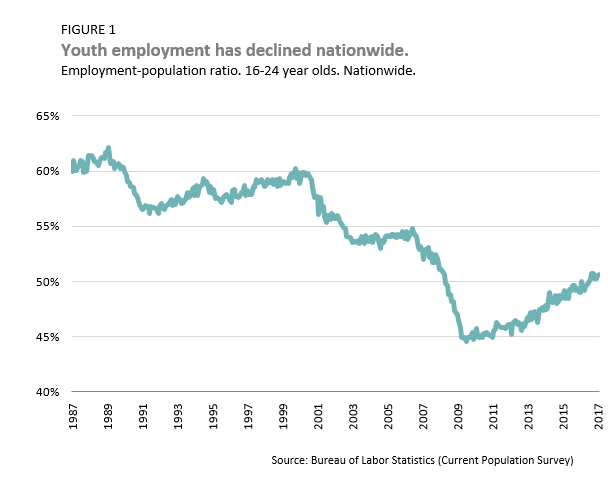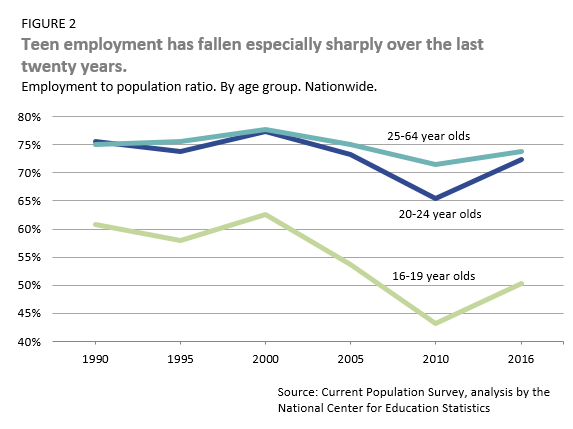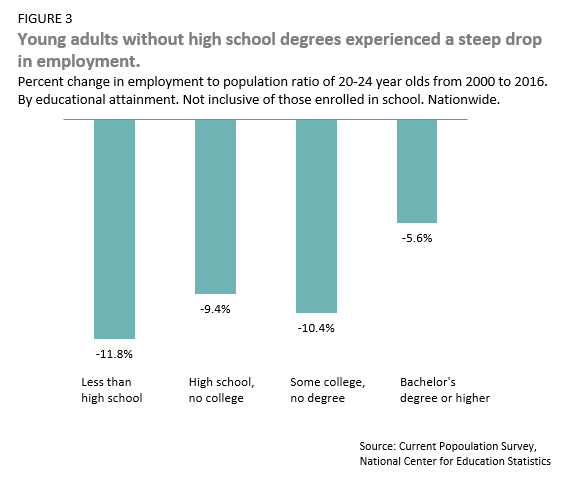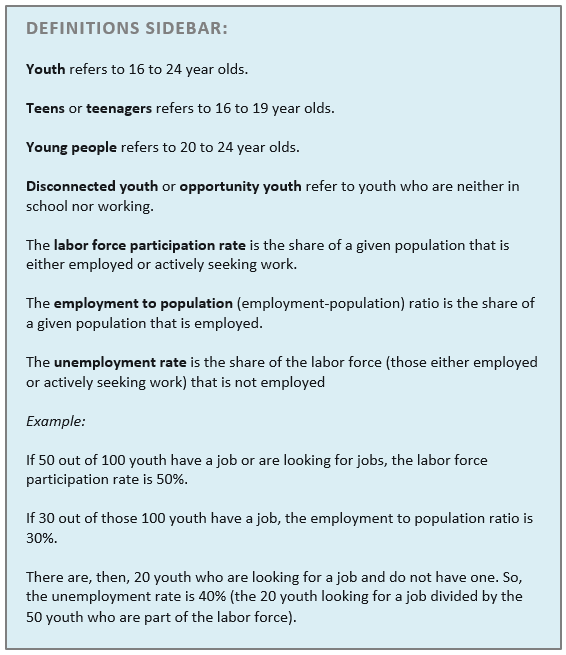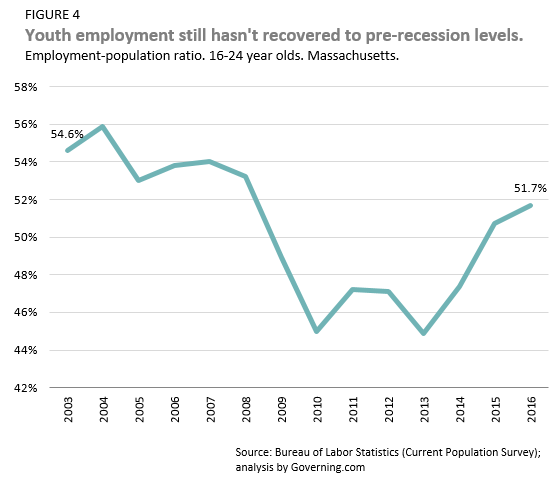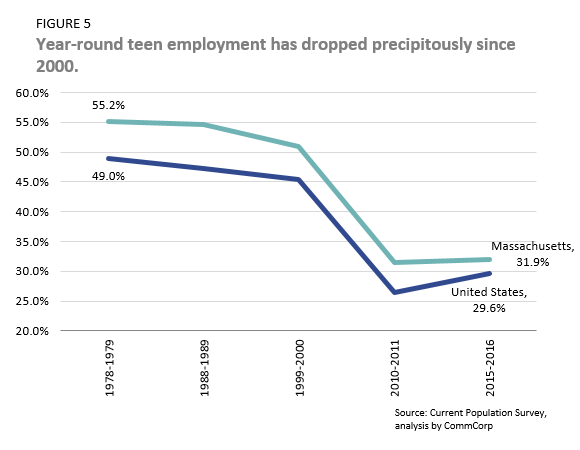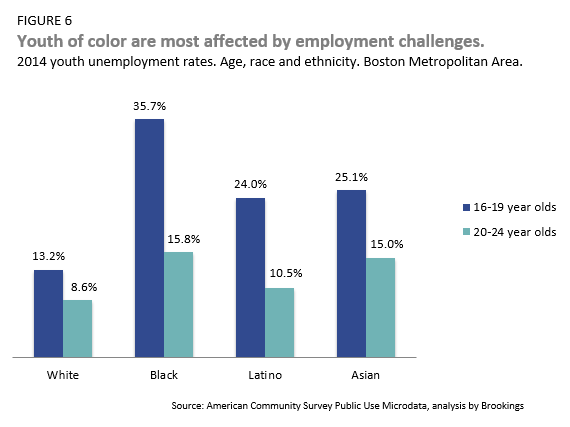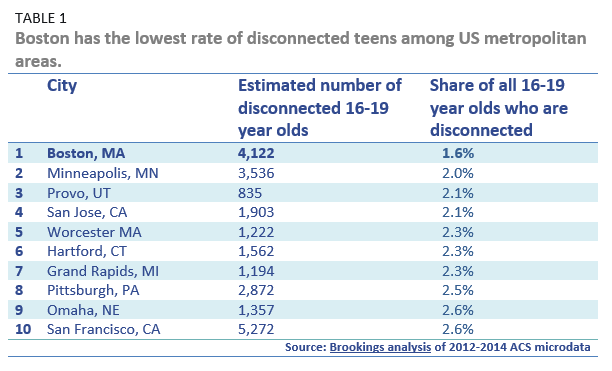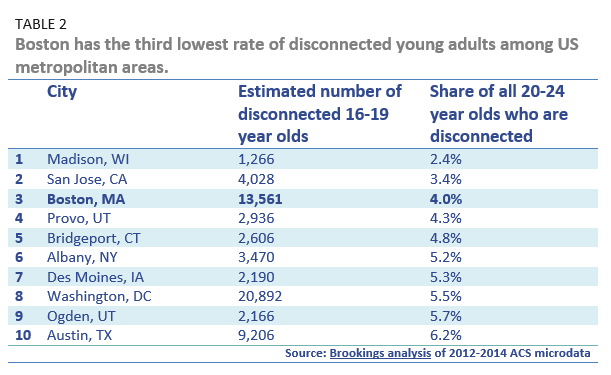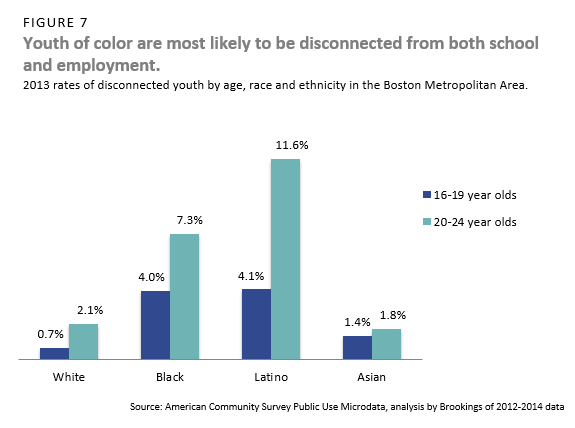The Decades-Long Decline in Youth Jobs
By Anise Vance
September 28, 2017
KEY INDICATORS
15%
decline in the share of young people aged 16-24 who were employed nationwide since 1990
12%
decrease in the share of 20-24 year olds without high school degrees who were employed since 1990
37%
drop in the share of teenagers who were employed in Massachusetts since 2000
#1
Greater Boston’s ranking among the 100 largest American cities in the share of teens either working or in school
OVERVIEW
Youth employment provides an essential introduction to the workforce for many teenagers and young adults. It helps them develop the skills necessary to succeed in a work environment, build a professional network and explore professions they would like to pursue. For some lower-income youth, working may also be necessary to help their families make ends meet.
Unfortunately, fewer young people today get early on-the-job experience, as youth employment has steadily declined over the last two decades. During the summer of 2000, 60 percent of youth were employed (including full and part-time work), whereas only 51 percent were employed this past summer. The Great Recession caused a particularly steep drop in the share of youth who were employed – from 54 percent in July 2006 to 46 percent in July 2012 – but this decline was well underway prior to the financial crisis. And while youth employment has rebounded in recent years, it’s still not back up to pre-recession levels even though we’re several years into an economic recovery.
The decline in youth employment is sharpest in two sub-populations: all teenagers and young adults without bachelor’s degrees. The share of teens that are employed has fallen by 17 percent since 1990. By comparison, the share of young adults that are employed contracted by 4 percent and that of adults aged 25 to 64 fell by 2 percent.
Young adults without bachelor’s degrees also experienced a significant decline in employment. Since 1990, there has been a 6 percent drop in the share of young adults with bachelor’s degree or higher that are employed. For all other educational attainment levels, the share of young adults who are employed fell by at least 9 percent.
Several changes in the broader economy have likely contributed to the decline in youth employment, including:
- As four-year college degrees have become increasingly important in the job market, more and more youth are attending postsecondary institutions, shrinking the youth labor force.
- Youth are facing increased competition for jobs as college graduates and older workers, struggling under difficult economic conditions, are forced to take lower-skill positions, agree to part-time work or postpone their retirements.
- Shifts in focus from after-school jobs to extracurricular activities and from vocational education to college preparatory classes have also likely contributed to a contracting youth labor force.
- Higher levels of high school enrollment during both the academic year and during the summer, more high school coursework and lengthier school days have led to lower youth employment.
YOUTH EMPLOYMENT IS DECLINING IN MASSACHUSETTS.
From 2003 to 2016, the youth employment to population ratio (the share of youth employed) fell from 54.6 percent to 51.7 percent. The employment to population ratio did momentarily stabilize in the mid-2000s, but was hit hard during the Great Recession and has only begun recovering in the past few years.
Among states, Massachusetts ranks 24th in the share of young people working. One contributing factor to the Commonwealth’s middle-of-the-pack ranking is likely the state’s unusually high proportion of college students. That said, the most striking decline in youth employment is among teens – many of whom are too young to choose college over work. Since 2000, the teen employment to population ratio, calculated as a yearly average, fell by 37 percent. This is roughly in line with the 35 percent drop in the United States, suggesting that national forces are at play in the Commonwealth.
In Greater Boston, teens of color are particularly likely to be affected by employment challenges. In 2014, black, Latino and Asian teens had unemployment rates above 24 percent (the unemployment rate of white teens was 13.2 percent). The black, Latino and Asian young adult populations also faced employment hurdles: each had an unemployment rate above 10 percent (the unemployment rate of white young adults was 8.6 percent).
GREATER BOSTON LEADS THE NATION IN CONNECTING YOUTH TO EMPLOYMENT OR SCHOOL, BUT THE CITY’S YOUTH OF COLOR NEED SUPPORT.
Youth who are neither working nor in school – sometimes referred to as “disconnected youth” or “opportunity youth” – are at the greatest risk of numerous negative outcomes, including long-term poverty, incarceration and substance abuse. Among the hundred largest metropolitan areas, Greater Boston has the lowest rate of disconnected teens, 1.6 percent, and the third lowest rate of disconnected young adults.
As well as Boston is doing in connecting youth to the workforce or education, significant disparities still exist by race and ethnicity. In the Greater Boston Area, 7.3 percent of black young adults and 11.6 percent of Latino young adults are neither working nor in school, rates more than triple that of their white and Asian counterparts.
WHAT’S BEING DONE LOCALLY?
Two major programs are central to local youth employment efforts. Statewide, YouthWorks, a summer and year-round employment program aimed at low-income youth, has helped 42,000 young people in 31 cities and towns find jobs. Importantly, YouthWorks also offers employment training, based on the Signal Success curriculum that helps youth develop the job readiness skills needed for long-term career success.
In Boston, the Mayor’s Summer Jobs Program connects approximately 900 employers to 10,000 youth. Over a six to eight week period, youth work about 25 hours per week for local nonprofits, city agencies and private companies. Supported through a combination of local, state and private funding, the program is a truly collaborative effort led by the municipal government.
Recent research suggests that Boston’s Summer Jobs Program has a significant impact on its participants. Youth involved in the program gain job readiness and social skills, positively alter their attitudes towards their communities and are more likely to consider attending college after finishing the program than before. Importantly, youth, particularly African-American and Hispanic males, are less likely to be involved in the criminal justice system, both during and after the program.
Boston is also home to My Summer in the City (MSITC), an innovative youth summer jobs initiative launched by the Boston Foundation in 2010. In addition to connecting 600 youth to employment opportunities, MSITC introduced pre-employment programming for 12 to 14 year olds, helping to build a bridge to youth employment.
While Boston’s summer jobs programs, and summer jobs programs more broadly, are not a panacea, they do provide a pathway to employment for teens and young adults hoping to work. In a city that aims to provide opportunities for all, they represent an important introduction to the workforce for many youth.

